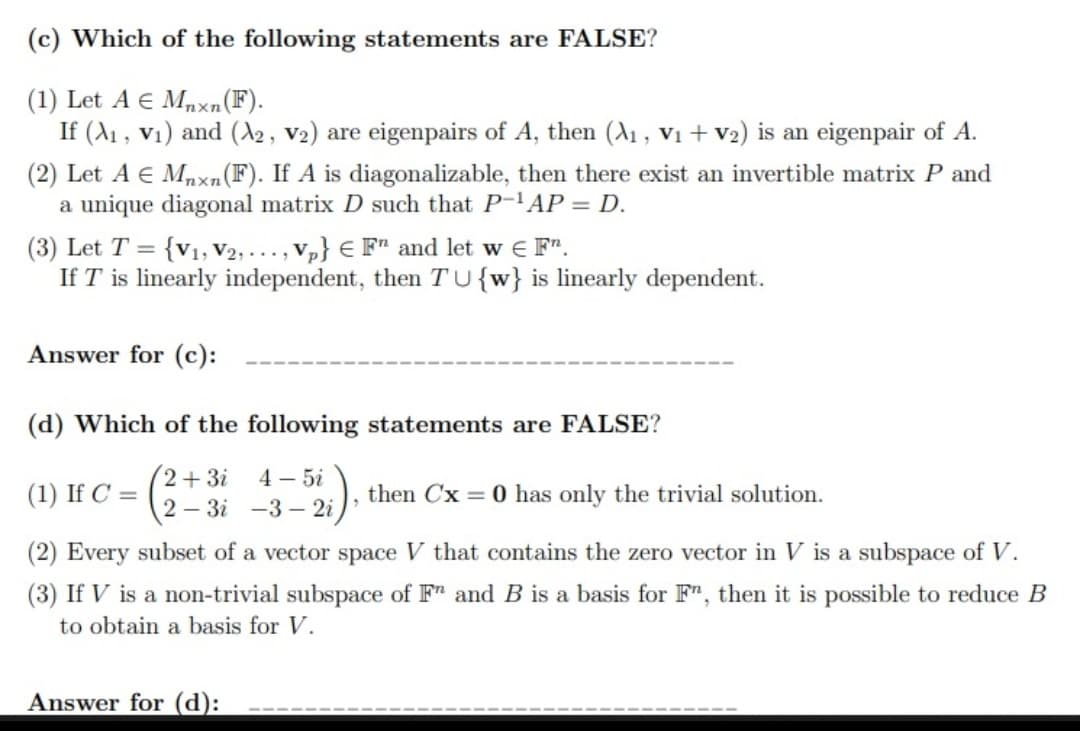(c) Which of the following statements are FALSE? (1) Let A E Mnxn(F). If (A1, v1) and (A2, v2) are eigenpairs of A, then (A1, v1 + v2) is an eigenpair of A. (2) Let A € Mnxn(F). If A is diagonalizable, then there exist an invertible matrix P and a unique diagonal matrix D such that P-AP = D. (3) Let T = {v1, V2, ..., V,} € F" and let w € F". If T is linearly independent, then TU{w} is linearly dependent. Answer for (c): (d) Which of the following statements are FALSE? 2+3i 4 - 5i (1) If C = then Cx = 0 has only the trivial solution. 2- 3і —3— 21, (2) Every subset of a vector space V that contains the zero vector in V is a subspace of V. (3) If V is a non-trivial subspace of F" and B is a basis for F", then it is possible to reduce B to obtain a basis for V. Answer for (d):
(c) Which of the following statements are FALSE? (1) Let A E Mnxn(F). If (A1, v1) and (A2, v2) are eigenpairs of A, then (A1, v1 + v2) is an eigenpair of A. (2) Let A € Mnxn(F). If A is diagonalizable, then there exist an invertible matrix P and a unique diagonal matrix D such that P-AP = D. (3) Let T = {v1, V2, ..., V,} € F" and let w € F". If T is linearly independent, then TU{w} is linearly dependent. Answer for (c): (d) Which of the following statements are FALSE? 2+3i 4 - 5i (1) If C = then Cx = 0 has only the trivial solution. 2- 3і —3— 21, (2) Every subset of a vector space V that contains the zero vector in V is a subspace of V. (3) If V is a non-trivial subspace of F" and B is a basis for F", then it is possible to reduce B to obtain a basis for V. Answer for (d):
Linear Algebra: A Modern Introduction
4th Edition
ISBN:9781285463247
Author:David Poole
Publisher:David Poole
Chapter5: Orthogonality
Section5.4: Orthogonal Diagonalization Of Symmetric Matrices
Problem 27EQ
Related questions
Question
No justification is required kindly give me ans asap

Transcribed Image Text:(c) Which of the following statements are FALSE?
(1) Let A E Mnxn(F).
If (A1, v1) and (A2, v2) are eigenpairs of A, then (A1, V1 + v2) is an eigenpair of A.
(2) Let A € Mnxn(F). If A is diagonalizable, then there exist an invertible matrix P and
a unique diagonal matrix D such that P-AP = D.
(3) Let T = {v1, V2, ..., V,} € F" and let w € F".
If T is linearly independent, then TU{w} is linearly dependent.
Answer for (c):
(d) Which of the following statements are FALSE?
2+3i
4 – 5i
(1) If C =
then Cx = 0 has only the trivial solution.
2 - Зі —3— 2і,
(2) Every subset of a vector space V that contains the zero vector in V is a subspace of V.
(3) If V is a non-trivial subspace of F" and B is a basis for F", then it is possible to reduce B
to obtain a basis for V.
Answer for (d):
Expert Solution
This question has been solved!
Explore an expertly crafted, step-by-step solution for a thorough understanding of key concepts.
Step by step
Solved in 2 steps with 2 images

Recommended textbooks for you

Linear Algebra: A Modern Introduction
Algebra
ISBN:
9781285463247
Author:
David Poole
Publisher:
Cengage Learning

Elementary Linear Algebra (MindTap Course List)
Algebra
ISBN:
9781305658004
Author:
Ron Larson
Publisher:
Cengage Learning

Linear Algebra: A Modern Introduction
Algebra
ISBN:
9781285463247
Author:
David Poole
Publisher:
Cengage Learning

Elementary Linear Algebra (MindTap Course List)
Algebra
ISBN:
9781305658004
Author:
Ron Larson
Publisher:
Cengage Learning